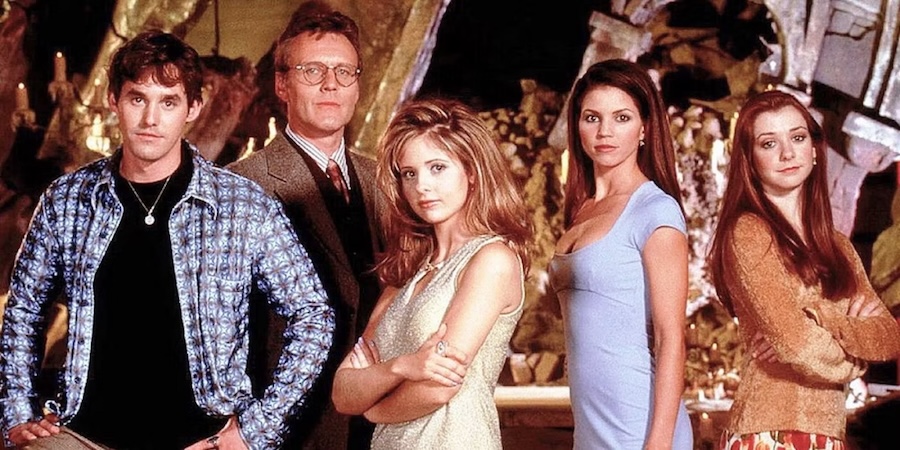ABOVE AVERAGE

I don’t know what Joss Whedon had in mind when he wrote the screenplay for a film called Buffy the Vampire Slayer (1992). Targeted for teens, it was obviously meant to be a comedy with a horror twist, about a blonde high school girl who lived for fashion and dating but discovered that she was predestined to become the Vampire Slayer. The movie starred Kristy Swanson as Buffy and Donald Sutherland as her mentor. Nobody paid much attention to this lame movie, but did Whedon forget all about it and move on? No way. Five years later, the TV series materialized – and it was a great success.
Life by the Hellmouth
Perhaps the reason for this was that now Whedon had greater creative control. Another reason could be that Sarah Michelle Gellar was much better as Buffy than Swanson. The set-up for the TV series was pretty much the same. Buffy lived in Sunnydale, a small town in California, which happened to be the place where the Hellmouth was located. Out of this Hellmouth came not only vampires but also many different kinds of demons and it was Buffy’s mission to kill as many of these evil creatures as possible. She had great help from Giles (Anthony Stewart Head), the earnest, British school librarian who functioned as her “Watcher”. His books provided all the information he and his young protégé needed about the demons in order to fight them. Buffy’s best friends, Xander and Willow (Nicholas Brendon, Alyson Hannigan), provided some comic relief.
The show quickly drew attention because of its violence (there were times when the special effects turned nasty for its target audience) and parents were somewhat uncomfortable with having their kids watch the mayhem. But it was also a show that addressed teenage problems in creative and humorous ways, and it was certainly by no means mean-spirited.
Getting wacky, and very amusing
The first three seasons were watchable enough but the fourth and fifth wowed audiences. It was as if allowing the teens to graduate from high school meant breaking totally free – this was when Buffy suddenly got a kid sister out of the blue, Willow explored her lesbian side and Giles opened a magic shop. This was when Buffy’s gang first had to fight a Frankenstein’s monster and then a sexy god. And this was also when Spike (James Marsters), an evil vampire from the first season, suddenly appeared again and got an implant which rendered him incapable of hurting humans, kind of turning him into a resentful pet that had nothing else to do with his time but occasionally help the gang fight Evil. The show, which always benefited from its feminist touch, got a little wacky, but very amusing.
The following seasons lost some of the magic, although an episode titled “Once More With Feeling” was memorable for its musical performances (!).
The outstanding performance on the show was delivered by James Marsters as Spike.
Gellar did a good job portraying a girl who constantly had to carry the world on her shoulders. She went through disastrous relationships (including with two vampires), the death of her mother and even her own death (and subsequent resurrection). But the outstanding performance on the show was delivered by Marsters as Spike, a thoroughly complex child of the night; a great part for an actor and Marsters never held back.
Buffy the Vampire Slayer 1997-2003:U.S. 144 episodes. Color. Created by Joss Whedon. Cast: Sarah Michelle Gellar (Buffy Summers), Nicholas Brendon (Xander Harris), Alyson Hannigan (Willow Rosenberg), Anthony Stewart Head (97-01, 02-03), James Marsters (97-98, 99-03), Emma Caulfield (99-03), Michelle Trachtenberg (00-03), David Boreanaz (97-99), Charisma Carpenter (97-99), Seth Green (97-99).
Trivia: Selma Blair and Katie Holmes were considered for the lead role. Followed by a spin-off series called Angel (1999-2004).
Last word: “My cast always came to play, always came knowing their stuff, doing the work, doing the best. Whatever bad energy they had before the cameras rolled, they didn’t put it on the screen. But at the same time, there was a lot of tension. Who that bleeds into are the crew, people who come in before – I was the only person coming in before the crew, and staying after the crew, and I get paid better. So I can’t complain. They were the people there first and there last, and energy like that flows down a chute, it makes it not as much fun a place. Still, this stuff kind of calmed down, we went seven years, we all kind of grew up. By the end, more professional.” (Whedon, IGN)
